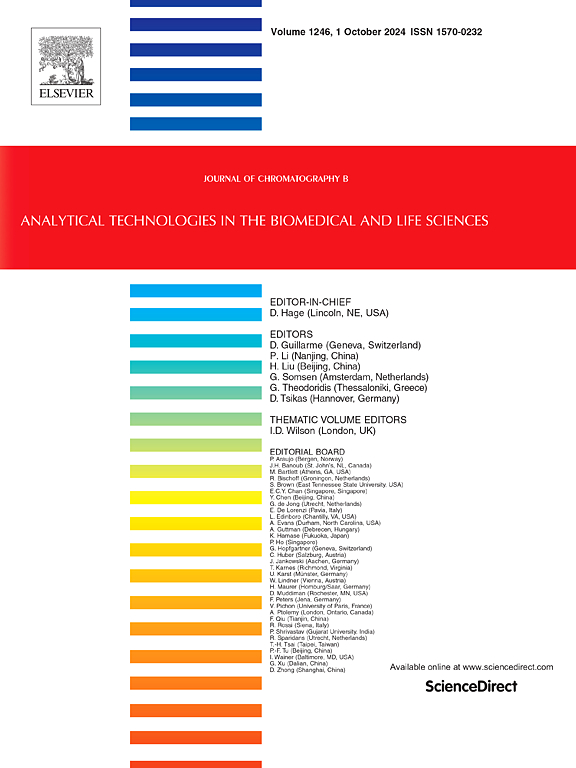Pentafluorobenzyl bromide – A versatile derivatization agent in chromatography and mass spectrometry: II. Analysis of organic acids and bases, and comparison with other perfluorinated reagents
IF 2.8
3区 医学
Q2 BIOCHEMICAL RESEARCH METHODS
引用次数: 0
Abstract
Analytical derivatization is an important for the vast majority of substances an indispensable sample preparation step for their quantitative GC–MS and GC–MS/MS analysis in biological samples. Pentafluorobenzyl bromide (PFB-Br), pentafluorobenzoyl chloride (PFB-COCl), pentafluorobenzyl hydroxylamine (PFB-NHNH2), pentafluorophenyl hydrazine (PFPh-ONH2), pentafluoropropionic anhydride (PFPA), and heptafluorobutyric anhydride (HFBA) are versatile derivatization reagents in analytical chemistry. In the present work, the utility of the above mentioned derivatization reagents for the GC–MS analysis of carboxylic, aldehydic, hydroxylic and amine groups containing analytes including amino acids is reviewed and discussed. Derivatization requires different conditions for solvents, reaction temperature and time, and possibly for catalysts. The perfluorinated derivatives are electrically neutral and best soluble in water-immiscible organic solvents such as toluene. Under negative-ion chemical ionization (NICI) conditions, the perfluorinated derivatives readily and abundantly ionize that allows for sensitive analysis. In addition, the perfluorinated analyte derivatives emerge earlier from GC columns than protiated, thus enabling shorter analysis times. Externally added 2H-, 13C-, 15N and 18O-isotopologs for use as internal standards undergo similar changes during derivatization, extraction by organic solvents, ionization in the ion-source of GC–MS apparatus and have almost identical retention times with the analytes. Due to selective analytical derivatization, almost all classes of endogenous and exogenous low-molecular-mass analytes, including drugs and inorganic anions such as nitrite, nitrate, carbonate, and (pseudo)halogenides, become accessible to quantitative GC–MS and GC–MS/MS analysis. Thanks the high sensitivity of quantitative analytical methods based on GC–MS and GC–MS/MS, very low amounts of perfluorinated derivatization reagents are consumed. In consideration of the enormously high global warming potential (GWP) of F-containing derivatization reagents, this article discussed a potential abandonment of the use of perfluorinated reagents and their replacement by F-free reagents in GC–MS and GC–MS/MS.
五氟苯溴-色谱和质谱中的多功能衍生化剂:II。有机酸和有机碱的分析,以及与其他全氟试剂的比较
分析衍生化是绝大多数物质在生物样品中定量GC-MS和GC-MS /MS分析中不可缺少的一个重要的制样步骤。五氟苯溴化(PFB-Br)、五氟苯酰氯(PFB-COCl)、五氟苯羟胺(PFB-NHNH2)、五氟苯肼(PFPh-ONH2)、五氟丙酸酐(PFPA)和七氟丁酸酐(HFBA)是分析化学中用途广泛的衍生化试剂。本文综述了上述衍生化试剂在含氨基酸的分析物中羧基、醛基、羟基和胺基的GC-MS分析中的应用。衍生化反应需要不同的溶剂、反应温度和时间条件,可能还需要不同的催化剂。全氟化衍生物电中性,最易溶于水不混溶的有机溶剂,如甲苯。在负离子化学电离(NICI)条件下,全氟化衍生物容易和充分电离,允许敏感分析。此外,全氟化分析物衍生物从气相色谱柱中出现的时间比质子化的要早,因此可以缩短分析时间。外部添加的2H-、13C-、15N和18o同位素作为内标物,在衍生化、有机溶剂萃取、气相色谱-质谱仪离子源电离过程中发生相似的变化,与分析物的保留时间几乎相同。由于选择性分析衍生化,几乎所有种类的内源性和外源性低分子质量分析物,包括药物和无机阴离子,如亚硝酸盐、硝酸盐、碳酸盐和(伪)卤化物,都可以进行定量GC-MS和GC-MS /MS分析。由于基于GC-MS和GC-MS /MS的定量分析方法具有很高的灵敏度,因此消耗的全氟衍生化试剂的量非常少。考虑到含氟衍生化试剂具有极高的全球变暖潜能值(GWP),本文讨论了在GC-MS和GC-MS /MS中放弃使用全氟试剂而代之以无氟试剂的可能性。
本文章由计算机程序翻译,如有差异,请以英文原文为准。
求助全文
约1分钟内获得全文
求助全文
来源期刊

Journal of Chromatography B
医学-分析化学
CiteScore
5.60
自引率
3.30%
发文量
306
审稿时长
44 days
期刊介绍:
The Journal of Chromatography B publishes papers on developments in separation science relevant to biology and biomedical research including both fundamental advances and applications. Analytical techniques which may be considered include the various facets of chromatography, electrophoresis and related methods, affinity and immunoaffinity-based methodologies, hyphenated and other multi-dimensional techniques, and microanalytical approaches. The journal also considers articles reporting developments in sample preparation, detection techniques including mass spectrometry, and data handling and analysis.
Developments related to preparative separations for the isolation and purification of components of biological systems may be published, including chromatographic and electrophoretic methods, affinity separations, field flow fractionation and other preparative approaches.
Applications to the analysis of biological systems and samples will be considered when the analytical science contains a significant element of novelty, e.g. a new approach to the separation of a compound, novel combination of analytical techniques, or significantly improved analytical performance.
 求助内容:
求助内容: 应助结果提醒方式:
应助结果提醒方式:


